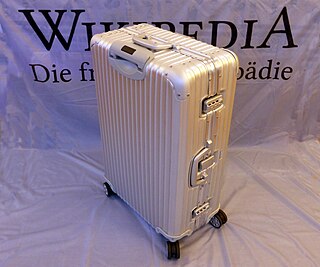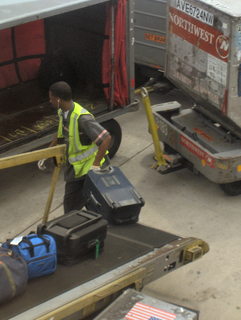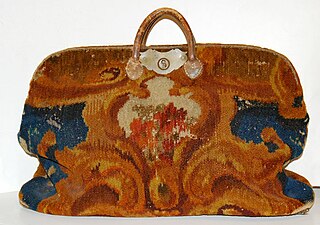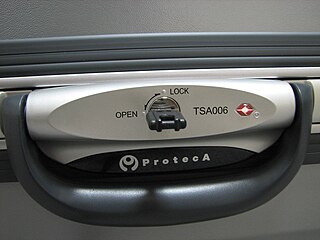 W
WA backpack—also called knapsack, rucksack, rucksac, pack, sackpack, booksack, bookbag or backsack—is, in its simplest frameless form, a cloth sack carried on one's back and secured with two straps that go over the shoulders, but it can have an external frame, internal frame, and there are bodypacks.
 W
WBaggage or luggage consists of bags, cases, and containers which hold a traveller's personal articles while the traveler is in transit. A modern traveller can be expected to have packages containing clothing, toiletries, small possessions, trip necessities. On the return trip, travelers may have souvenirs and gifts. For some people, luggage and the style thereof is representative of the owner's wealth and status. Luggage is constructed to protect the items during travel, either with a hard shell or a durable soft material. Luggage often has internal subdivisions or sections to aid in securing items. Handles are typically provided to facilitate carrying, and some luggage may have wheels and/or telescoping handles or leashes to make moving them easier.
 W
WOn the commercial transportation, mostly with airlines, the baggage allowance is the amount of checked baggage or hand/carry-on luggage the company will allow per passenger. There may be limits on the amount that is allowed free of charge, and hard limits on the amount that is allowed.
 W
WA baggage carousel is a device, generally at an airport, that delivers checked luggage to the passengers at the baggage reclaim area at their final destination. Not all airports use these devices. Airports without carousels generally deliver baggage by placing it on the floor or sliding it through an opening in a wall.
 W
WBaggage carts, luggage carts, luggage trolleys or trolleys are small vehicles pushed by travelers (human-powered) to carry individual luggage, mostly suitcases. There are two major sizes: One for big luggage and one for small luggage. Carts have usually two parts for carrying luggage: A small section (basket) for carry on luggage at the same level as the handle, and a lowered large section for suitcases a small and large bags.
 W
WIn the airline industry, a baggage handler is a person who loads and unloads baggage, and other cargo for transport via aircraft. With most airlines, the formal job title is "fleet service agent/clerk", though the position is commonly known amongst airline employees as a "ramp agent", due to the job's location on the airport ramp (tarmac).
 W
WA baggage handling system (BHS) is a type of conveyor system installed in airports that transports checked luggage from ticket counters to areas where the bags can be loaded onto airplanes. A BHS also transports checked baggage coming from airplanes to baggage claims or to an area where the bag can be loaded onto another airplane.
 W
WIn airport terminals, a baggage reclaim area is an area where arriving passengers claim checked-in baggage after disembarking from an airline flight. The alternative term baggage claim is used at airports in the US and some other airports internationally. Similar systems are also used at train stations served by companies that offer checked bags, such as Amtrak in the United States.
 W
WBag tags, also known as baggage tags, baggage checks or luggage tickets, have traditionally been used by bus, train, and airline carriers to route checked luggage to its final destination. The passenger stub is typically handed to the passenger or attached to the ticket envelope:
 W
WA bindle is the bag, sack, or carrying device stereotypically used by the American sub-culture of hobos. A "bindlestiff" was another name for a hobo who carried a bindle. The bindle is colloquially known as the "blanket stick", particularly within the Northeastern hobo community. A "bindlestiff", according to James Blish in his novel, A Life for the Stars, was about a hobo who stole another hobo's "bindle," hence the colloquium "stiff" as in steal.
 W
WA briefcase is a narrow hard-sided box-shaped bag or case used mainly for carrying papers and equipped with a handle. Lawyers commonly use briefcases to carry briefs to present to a court, hence the name. Businesspeople and other white collar professionals also use briefcases to carry papers, and since the 1980s, electronic devices such as laptop computers and tablet computers. Some briefcases have only a main internal space, while others may have subsections, accordion sections, small pockets, or dividers. Briefcases may be made from leather, vinyl, durable fabric, thin metal, or plastic. Leather, vinyl, or fabric briefcases may have externally-accessible pockets or sleeves in addition to the main storage space. Some briefcases made of fabric may have a shoulder strap. Briefcases typically have a lock to protect the contents. Nowadays, briefcases may have padded internal pouches to protect laptop computers.
 W
WA canoe pack, also known as a portage pack, is a specialized type of backpack used primarily where travel is largely by water punctuated by portages where the gear needs to be carried over land.
 W
WA carpet bag is a top-opening travelling bag made of carpet, commonly from an oriental rug. It was a popular form of luggage in the United States and Europe in the 19th century, featuring simple handles and only an upper frame, which served as its closure. Some small modern versions are used as handbags or purses.
 W
WChecked baggage is luggage delivered to an airline or train for transportation in the hold of an aircraft or baggage car of a passenger train. Checked baggage is inaccessible to the passenger during the flight or ride, as opposed to carry-on baggage.
 W
WA duffel bag, duffle bag, or kit bag is a large bag either natural or synthetic fabric, historically with a top closure using a drawstring. Generally a duffel bag is used by non-commissioned personnel in the military, and for travel, sports and recreation by civilians. When used by sailors or marines a duffel is known as a seabag. A duffel's open structure and lack of rigidity makes it adaptable to carrying sports gear and similar bulky objects.
 W
WA Duluth pack is traditional portage pack used in canoe travel, particularly in the Boundary Waters region of northern Minnesota and the Quetico Provincial Park of Ontario. A specialized type of backpack, Duluth packs are made of heavy canvas, leather, and/or cordura nylon, and are nearly square in order to fit easily in the bottom of a canoe.
 W
WA flight bag can refer to any baggage taken on board a flight, but usually refers to a specific type of document bag carried by pilots and flight crews. Often adorned with an airline logo, at one time the flight bag was a chic fashion accessory.
 W
WA footlocker is a cuboid container used by soldiers or other military personnel to store their belongings. They are known as footlockers because they are a type of locker which is usually located at the foot of a soldier's bunk or bed. The term "footlocker" is currently used in recruit training in the United States Marine Corps.
 W
WA Gladstone bag is a small portmanteau suitcase built over a rigid frame which could separate into two equal sections. Unlike a suitcase, a Gladstone bag is "deeper in proportion to its length." Gladstones are typically made of stiff leather and often belted with lanyards. The bags are named after William Ewart Gladstone (1809–1898), the four-time Prime Minister of the United Kingdom.
 W
WThe term hand luggage or cabin baggage refers to the type of luggage that passengers are allowed to carry along in the passenger compartment of a vehicle instead of moving to the cargo compartment. Passengers are allowed to carry a limited number of smaller bags with them in the vehicle and contain valuables and items needed during the journey. There is normally storage space provided for hand luggage, either under seating, or in overhead lockers. Trains usually have luggage racks above the seats and may also have luggage space between the backs of seats facing opposite directions, or in extra luggage racks, for example, at the ends of the carriage near the doors.
 W
WA hat box and occasionally referred to as a bandbox, is a container for storing and transporting headgear, protecting it from damage and dust. A more generic term for a box used to carry garments, including headgear, is a bandbox. Typically, a hat box is deep and round in shape, although it may also be boxlike and used as an item of luggage for transporting a variety of hats.
 W
WLost luggage is luggage conveyed by a public carrier such as an airline, seafaring cruise ship, shipping company, or railway which fails to arrive at the correct destination with the passenger. In the United States, an average of 1 in 150 people have their checked baggage misdirected or left behind each year.
 W
WA luggage lock is a lock used to prevent luggage from opening by accident, usually with little or no security in mind, although they may serve as a deterrent to potential thieves. They may be built into luggage, or may be external locks such as padlocks or lockable straps. They are typically relatively simple low security locks.
 W
WA messenger bag is a type of sack, usually made of cloth. It is worn over one shoulder with a strap that goes across the chest resting the bag on the lower back. While messenger bags are sometimes used by couriers, they are now also an urban fashion icon. Some types of messenger bags are called carryalls. A smaller version is often called a sling bag.
 W
WA pannier is a basket, bag, box, or similar container, carried in pairs either slung over the back of a beast of burden, or attached to the sides of a bicycle or motorcycle. The term derives from a Middle English borrowing of the Old French panier, meaning 'bread basket'.
 W
WThe pasiking is the indigenous basket-backpack found among the various ethno-linguistic groups of Northern Luzon in the Philippines. Pasiking designs have sacred allusions, although most are purely aesthetic. These artifacts, whether handwoven traditionally or with contemporary variations, are considered exemplars of functional basketry in the Philippines and among Filipinos.
 W
WPersonal Load Carrying Equipment (PLCE) is one of several current tactical webbing systems of the British Armed Forces. Dependent upon the year of design, and the decade of introduction, the webbing system was designated, and is commonly referred to, as either the 85 Pattern, the 90 Pattern or the 95 Pattern webbing.
 W
WA portmanteau is a piece of luggage, usually made of leather and opening into two equal parts. Some were large, upright, and hinged at the back and enabled hanging up clothes in one half, while others are much smaller bags with two equally sized compartments.
 W
WA satchel is a bag with a strap, traditionally used for carrying books. The strap is often worn so that it diagonally crosses the body, with the bag hanging on the opposite hip, rather than hanging directly down from the shoulder. The back of a satchel extends to form a flap that folds over to cover the top and fastens in the front. Unlike a briefcase, a satchel is soft-sided.
 W
WSend My Bag is a luggage shipping company for that aims to allow travelers to transport baggage, claiming a lower cost than airline baggage handling fees.
 W
WA suitcase is a form of luggage. It is often a somewhat flat, rectangular-shaped bag with rounded square corners, either metal, hard plastic or made of cloth, vinyl or leather that more or less retains its shape. Vinyl, leather or cloth suitcases may have a metal frame. It has a carrying handle on one side and is used mainly for transporting clothes, toiletries and other small possessions during trips. Hardshell suitcases open on hinges like a door. Suitcases may lock with keys or a combination.
 W
WA travel pack is a specialized type of rucksack developed for adventurers, and popular with backpackers. Much like ordinary rucksacks in appearance, travel packs have the added benefit of being able to zip shoulder straps, hip belts and shoulder harnesses out of sight. Additionally, many travel packs, being internal frame packs, have concealed parallel stays designed to offer added support.
 W
WA trunk, also known as a travel trunk, is a large cuboid container designed to hold clothes and other personal belongings. They are most commonly used for extended periods away from home, such as for boarding school, or long trips abroad. Trunks are differentiated from chests by their more rugged construction due to their intended use as luggage, instead of the latter's pure storage.